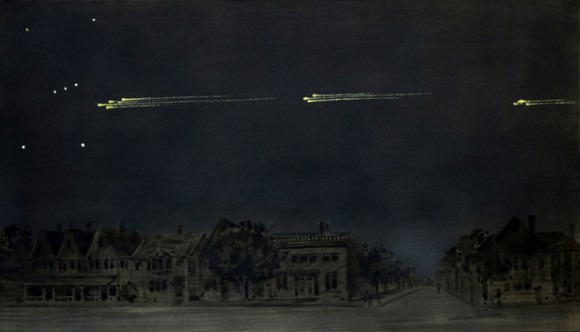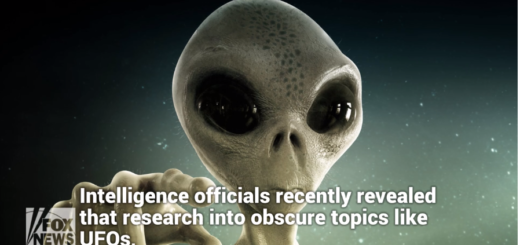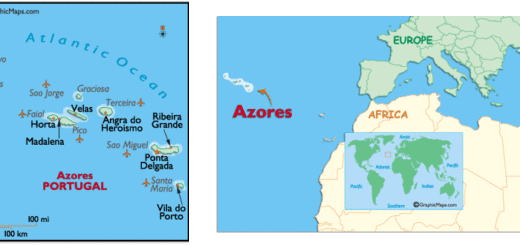Anniversary Of Mysterious Parade Of Meteors

Today in science: February 9, 1913. An odd and still-unexplained parade of meteors on this date dazzled viewers in Canada, the northeastern United States, and ships in the Atlantic all the way down to Brazil. The event is usually known by the name the Great Meteor Procession of 1913, and after more than a century, its origins are still unknown.
This procession of meteors was unlike other meteor events, where zippy streaks of light all radiate outward from a single point. The February 9, 1913, meteors appeared to cross the sky in formation, on nearly identical paths. Their pace across the sky was described as stately and measured.
Another difference between your average meteor and the 1913 procession was that normal meteors tend to plunge into Earth’s atmosphere and vaporize due to friction with the air. Meteors in annual showers last only seconds. The 1913 meteors appeared to travel almost horizontally, nearly parallel to the Earth’s surface, and thus they remained visible to a single observer for about a minute, and the entire procession took several minutes to pass by.
Plus, rumblings and other strange sounds were reported, suggesting the 1913 meteors could have been relatively close to Earth when they disintegrated.
EarthSky lunar calendars are back in stock! We’re guaranteed to sell out – get one while you can.
Some astronomers later concluded that – because all sightings of the meteor procession occurred along a great circle arc – the source had been a small, short-lived natural satellite of Earth – a temporary second moon. Other theories attempted to prove there was a radiant point for this shower, just as for any ordinary meteor shower.
The densely populated northeastern United States was cloudy on the evening of February 9, 1913. So 30 million potential observers were for the most part unaware of the phenomenon. A 1913 report in the Journal of the Royal Astronomical Society of Canada by Clarence Chant, who collected over 100 eyewitness reports of the event, described the scene like this:
A huge meteor appeared traveling from northwest by west to southeast, which, as it approached, was seen to be in two parts and looked like two bars of flaming material, one following the other. They were throwing out a constant stream of sparks and after they had passed they shot out balls of fire straight ahead that travelled more rapidly than the main bodies. They seemed to pass over slowly and were in sight about five minutes. Immediately after their disappearance in the southeast a ball of clear fire, that looked like a big star, passed across the sky in their wake. This ball did not have a tail or show sparks of any kind. Instead of being yellow like the meteors, it was clear like a star.
Enjoying EarthSky so far? Sign up for our free daily newsletter today!
Part of globe with red dots along a great circle line from Yukon to South Atlantic.
The red dots mark observed locations of the Great Meteor Procession of 1913. View larger. Map via Sky & Telescope/ Texas State University.
Don Olson of Texas State University and Steve Hutcheon of the Astronomical Association of Queensland, Australia, have studied this phenomenon. Sifting through a vast array of archival material, the team discovered seven ship’s reports, all previously unknown, extending the established track of the procession by an additional thousand miles. They reported their results in a 2013 issue of Sky & Telescope magazine. Read more about Olson and Hutcheon’s findings here.
Meanwhile, the exact origin of the meteors in the 1913 meteor procession may never be known for sure.



 Creators of mankind
Creators of mankind Description of “Tall white aliens”
Description of “Tall white aliens” Where they came from?
Where they came from? About hostile civilizations
About hostile civilizations The war for the Earth
The war for the Earth “Tall white aliens” about eternal life
“Tall white aliens” about eternal life Video: “Nordic aliens”
Video: “Nordic aliens” Aliens
Aliens Alien encounters
Alien encounters The aliens base
The aliens base UFO
UFO Technology UFO
Technology UFO Underground civilization
Underground civilization Ancient alien artifacts
Ancient alien artifacts Military and UFO
Military and UFO Mysteries and hypotheses
Mysteries and hypotheses Scientific facts
Scientific facts


















